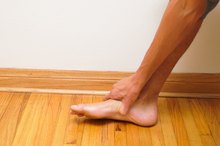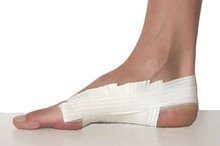How Do I Wrap a Sprained Ankle?
Sprained ankles are common injuries, especially in athletes. An ankle sprain typically presents with swelling, bruising and pain to the ankle and foot. If you have sprained your ankle, see a doctor. She can rule out a more serious injury such as a fracture. Treatment for a sprained ankle usually consists of “R.I.C.E.,” or rest, ice, compression and elevation. Wrapping a sprained ankle applies a form of compression to the injured tissue in order to help reduce swelling and pain that accompany a sprain, helping you to get back on your feet sooner.
Roll up the entire wrap. A 4-inch-wide wrap works best. Position yourself so that your leg is supported and your foot is off the ground. You'll need to keep your foot and ankle at a 90-degree angle throughout this process.
How to Wrap Achilles Tendon
Learn More
Lay the ACE wrap across the top of the foot, just behind your toes. The wrap should come off the bottom of the roll, not the top. Hold the wrap in place behind your toes, and wrap it around the ball of the foot back over the first layer to anchor it in place. Make sure you're not applying too much pressure; tighter is not always better.
Pull the wrap diagonally from your toes across the top of your foot, and slowly under the arch in a figure-eight fashion. Each consecutive wrap should cover about 50 percent of the previous wrap.
How to Wrap a Pulled Quad With Athletic Tape
Learn More
Bring the wrap around the ankle bone and back down to the foot. Continue the figure-eight style until the entire foot, including the heel, is completely covered with no skin showing.
Wrap at least 3 inches above the ankle bone on the leg, using the same technique. When you reach the end of the roll, secure the tag end with the provided clips or a small piece of athletic tape.
Check the circulation in your toes to ensure the wrap isn't too tight. If your toes turn a bluish-gray color, become numb, or if they feel cold to the touch, your wrap is too tight and must be adjusted. If you can comfortably insert a finger under the wrap, it should be the right tightness.
Tips
If the doctor has given you a brace, use it instead of wrapping. Check the wrap periodically for loosening or changes in swelling. Always start just behind your toes. You may need two anchor wraps to keep the wrap in place.
Warnings
A wrap that is too tight can do more harm than good. Make sure to check the circulation in your toes when you are done. Make sure there are no wrinkles in the wrap. If there are, try to smooth them out, or re-wrap the foot and ankle. Check your feet before wrapping to make sure they're clean and free of debris.
Related Articles
References
- Wheeless' Textbook of Orthopaedics
- Martin R, McGovern R. Managing ankle ligament sprains and tears: current opinion. Open Access J Sports Med. 2016;7:33-42. doi:10.2147/oajsm.s72334
- American Academy of Orthopaedic Surgeons. Sprained Ankle. Updated February 2016.
- Khor YP, Tan KJ. The Anatomic Pattern of Injuries in Acute Inversion Ankle Sprains: A Magnetic Resonance Imaging Study. Orthop J Sports Med. 2013;1(7):2325967113517078. doi:10.1177/2325967113517078
- Dewar RA, Arnold GP, Wang W, Drew TS, Abboud RJ. The effects of wearing an Ankle Stabilizing Orthosis (ASO) Ankle Brace on ankle joints kinetics and kinematics during a basketball rebounding task.Foot (Edinb). 2019 May 7;40:34-38. doi: 10.1016/j.foot.2019.05.003. [Epub ahead of print]
- Mun JU, Cho HR, Sung YJ, Kang KN, Lee J, Joo Y et al. The role of the anterior talofibular ligament area as a morphological parameter of the chronic ankle sprain.J Orthop Sci. 2019 May 16. pii: S0949-2658(19)30129-0. doi: 10.1016/j.jos.2019.05.001. [Epub ahead of print]
Writer Bio
Tyler Shultz is a third-year doctor of physical therapy student at the Medical College of Georgia in Augusta, Ga. His articles have appeared in numerous physical therapy blogs since 2009, including PT ThinkTank and AAOMPT-sSIG blog. Tyler graduated from the University of Georgia with a Bachelor of Science in health promotion in 2007.









